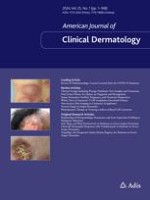01-12-2003 | Current Opinion
Is Antibiotic Resistance in Cutaneous Propionibacteria Clinically Relevant?
Implications of Resistance for Acne Patients and Prescribers
Published in: American Journal of Clinical Dermatology | Issue 12/2003
Login to get accessAbstract
It is well recognized that some patients with acne do not respond adequately to antibiotic therapy. It is important to distinguish antibiotic recalcitrant acne which we would suggest represents acne that shows a diminished response to treatment irrespective of the cause as opposed to ‘antibiotic-resistant acne’ which is acne that is less responsive to treatment as a direct consequence of skin colonization with resistant propionibacteria. Here we show that antibiotic-resistant acne is not just a theoretical possibility but a real phenomenon that could have important consequences for patients and prescribers. The relationship between skin colonization by antibiotic-resistant propionibacteria and treatment outcomes is a complex one that is explained at the follicular level by physiological differences affecting local drug concentrations. A systematic review of the literature on antibiotic-resistant propionibacteria revealed methodological shortcomings in studies of their prevalence and a paucity of evidence on their clinical significance. Despite the elucidation of resistance mechanisms in cutaneous propionibacteria, our continuing inability to distinguish between strains of Propionibacterium acnes means that we still do not fully understand how resistance spreads, although person-to-person transfer is most likely. Finally, we present a decision tree for acne management in an era of prudent antimicrobial prescribing that provides an alternative to existing treatment algorithms by placing topical retinoids and not antibiotics at the cornerstone of acne management.





